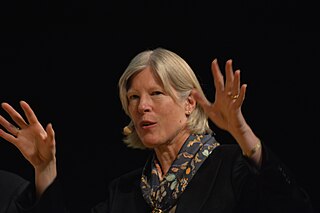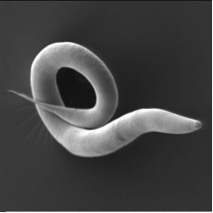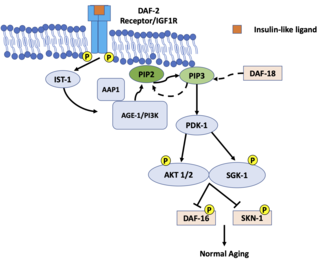Related Research Articles

The insulin-like growth factors (IGFs) are proteins with high sequence similarity to insulin. IGFs are part of a complex system that cells use to communicate with their physiologic environment. This complex system consists of two cell-surface receptors, two ligands, a family of seven high-affinity IGF-binding proteins, as well as associated IGFBP degrading enzymes, referred to collectively as proteases.

Caenorhabditis elegans is a free-living transparent nematode about 1 mm in length that lives in temperate soil environments. It is the type species of its genus. The name is a blend of the Greek caeno- (recent), rhabditis (rod-like) and Latin elegans (elegant). In 1900, Maupas initially named it Rhabditides elegans. Osche placed it in the subgenus Caenorhabditis in 1952, and in 1955, Dougherty raised Caenorhabditis to the status of genus.
Calorie restriction mimetics (CRM), also known as energy restriction mimetics, are a hypothetical class of dietary supplements or drug candidates that would, in principle, mimic the substantial anti-aging effects that calorie restriction (CR) has on many laboratory animals and humans. CR is defined as a reduction in calorie intake of 20% to 50% without incurring malnutrition or a reduction in essential nutrients. An effective CRM would alter the key metabolic pathways involved in the effects of CR itself, leading to preserved youthful health and longer lifespan without the need to reduce food intake. The term was coined by Lane, Ingram, Roth of the National Institute on Aging in a seminal 1998 paper in the Journal of Anti-Aging Medicine, the forerunner of Rejuvenation Research. A number of genes and pathways have been shown to be involved with the actions of CR in model organisms and these represent attractive targets for drug discovery and for developing CRM. However, no effective CRM have been identified to date.
Dauer describes an alternative developmental stage of nematode worms, particularly rhabditids including Caenorhabditis elegans, whereby the larva goes into a type of stasis and can survive harsh conditions. Since the entrance of the dauer stage is dependent on environmental cues, it represents a classic and well studied example of polyphenism. The dauer state is given other names in the various types of nematodes such as ‘diapause’ or ‘hypobiosis’, but since the C. elegans nematode has become the most studied nematode, the term ‘dauer stage’ or 'dauer larvae' is becoming universally recognised when referring to this state in other free-living nematodes. The dauer stage is also considered to be equivalent to the infective stage of parasitic nematode larvae.

Cynthia Jane Kenyon is an American molecular biologist and biogerontologist known for her genetic dissection of aging in a widely used model organism, the roundworm Caenorhabditis elegans. She is the vice president of aging research at Calico Research Labs, and emeritus professor of biochemistry and biophysics at the University of California, San Francisco (UCSF).

SHC-transforming protein 1 is a protein that in humans is encoded by the SHC1 gene. SHC has been found to be important in the regulation of apoptosis and drug resistance in mammalian cells.

Forkhead box O3, also known as FOXO3 or FOXO3a, is a human protein encoded by the FOXO3 gene.

Forkhead box protein O4 is a protein that in humans is encoded by the FOXO4 gene.
Gary Bruce Ruvkun is an American molecular biologist at Massachusetts General Hospital and professor of genetics at Harvard Medical School in Boston. Ruvkun discovered the mechanism by which lin-4, the first microRNA (miRNA) discovered by Victor Ambros, regulates the translation of target messenger RNAs via imperfect base-pairing to those targets, and discovered the second miRNA, let-7, and that it is conserved across animal phylogeny, including in humans. These miRNA discoveries revealed a new world of RNA regulation at an unprecedented small size scale, and the mechanism of that regulation. Ruvkun also discovered many features of insulin-like signaling in the regulation of aging and metabolism. He was elected a Member of the American Philosophical Society in 2019.

DAF-16 is the sole ortholog of the FOXO family of transcription factors in the nematode Caenorhabditis elegans. It is responsible for activating genes involved in longevity, lipogenesis, heat shock survival and oxidative stress responses. It also protects C.elegans during food deprivation, causing it to transform into a hibernation - like state, known as a Dauer. DAF-16 is notable for being the primary transcription factor required for the profound lifespan extension observed upon mutation of the insulin-like receptor DAF-2. The gene has played a large role in research into longevity and the insulin signalling pathway as it is located in C. elegans, a successful ageing model organism.
David Gems is a British geneticist who studies the biology and genetics of ageing (biogerontology). He is Professor of Biogerontology at the Research Department of Genetics, Evolution and Environment, University College London and he is a co-founder and Research Director of the UCL Institute of Healthy Ageing. His work concerns understanding the underlying causes of aging. His research laboratory tests theories of aging and develops new ones using a short-lived animal model C. elegans.
In molecular biology mir-71 microRNA is a short RNA molecule. MicroRNAs function to regulate the expression levels of other genes by several mechanisms.

Genetics of aging is generally concerned with life extension associated with genetic alterations, rather than with accelerated aging diseases leading to reduction in lifespan.

Caenorhabditis elegans- microbe interactions are defined as any interaction that encompasses the association with microbes that temporarily or permanently live in or on the nematode C. elegans. The microbes can engage in a commensal, mutualistic or pathogenic interaction with the host. These include bacterial, viral, unicellular eukaryotic, and fungal interactions. In nature C. elegans harbours a diverse set of microbes. In contrast, C. elegans strains that are cultivated in laboratories for research purposes have lost the natural associated microbial communities and are commonly maintained on a single bacterial strain, Escherichia coli OP50. However, E. coli OP50 does not allow for reverse genetic screens because RNAi libraries have only been generated in strain HT115. This limits the ability to study bacterial effects on host phenotypes. The host microbe interactions of C. elegans are closely studied because of their orthologs in humans. Therefore, the better we understand the host interactions of C. elegans the better we can understand the host interactions within the human body.
The DAF-12 gene encodes the nuclear receptor of dafachronic acid in the worm Caenorhabditis elegans, with the NRNC Symbol NR1J1 as the homolog of nuclear hormone receptor HR96 in Drosophila melanogaster. DAF-12 has been implicated by Cynthia Kenyon and colleagues in the formation of Dauer larva.
The Daf-9 gene encodes a cytochrome p450 enzyme catalysis the generation of dafachronic acid in the worm Caenorhabditis elegans, with the CYP Symbol CYP22A1. After generation, dafachronic acid will binding it's nuclear receptor Daf-12 and has been implicated by Cynthia Kenyon and colleagues related to the formation of Dauer larva.
The DAF-1 gene encodes for a cell surface Enzyme-linked receptor of TGF-beta signaling pathway in the worm Caenorhabditis elegans. DAF-1 is one of the type I receptor of TGF-beta pathway. DAF-1 acts as a receptor protein serine/threonine kinase, is activated by type II receptor Daf-4 phosphorylation after the ligand Daf-7 binds to the receptor heterotetramer, and then phosphorylates Daf-8 or Daf-14, the SMAD proteins in C. elegans.
The Dod-13 gene in the worm Caenorhabditis elegans encoding a cytochrome p450 enzyme, which have steroid hydroxylase activity, with the CYP Symbol CYP35B1. Dod-13 is downstream gene of Daf-16 influenced the lifespan of C. elegans.

Collin Yvès Ewald is a Swiss scientist investigating the molecular mechanisms of healthy aging. He is a molecular biologist and a professor at ETH Zurich, where he leads the Laboratory of Extracellular Matrix Regeneration. His research focuses on the remodeling of the extracellular matrix during aging and upon longevity interventions.

The age-1 gene is located on chromosome 2 in C.elegans. It gained attention in 1983 for its ability to induce long-lived C. elegans mutants. The age-1 mutant, first identified by Michael Klass, was reported to extend mean lifespan by over 50% at 25 °C when compared to the wild type worm (N2) in 1987 by Johnson et al. Development, metabolism, lifespan, among other processes have been associated with age-1 expression. The age-1 gene is known to share a genetic pathway with daf-2 gene that regulates lifespan in worms. Additionally, both age-1 and daf-2 mutants are dependent on daf-16 and daf-18 genes to promote lifespan extension.
References
- 1 2 Kenyon C (January 2011). "The first long-lived mutants: discovery of the insulin/IGF-1 pathway for ageing". Philos Trans R Soc Lond B Biol Sci. 366 (1561): 9–16. doi:10.1098/rstb.2010.0276. PMC 3001308 . PMID 21115525.
- ↑ Gami MS, Wolkow CA (February 2006). "Studies of Caenorhabditis elegans DAF-2/insulin signaling reveal targets for pharmacological manipulation of lifespan". Aging Cell. 5 (1): 31–7. doi:10.1111/j.1474-9726.2006.00188.x. PMC 1413578 . PMID 16441841.
- ↑ Dorman JB, Albinder B, Shroyer T, Kenyon C (December 1995). "The age-1 and daf-2 genes function in a common pathway to control the lifespan of Caenorhabditis elegans". Genetics. 141 (4): 1399–1406. doi:10.1093/genetics/141.4.1399. PMC 1206875 . PMID 8601482.
- ↑ Apfeld J, Kenyon C (October 1998). "Cell nonautonomy of C. elegans daf-2 function in the regulation of diapause and life span". Cell. 95 (2): 199–210. doi: 10.1016/s0092-8674(00)81751-1 . PMID 9790527.
- ↑ Krulwich, R. (Performer) (2007, June 14). Mortality. Radiolab. [Audio podcast]. Retrieved from http://www.radiolab.org/2007/jun/14/
- 1 2 3 Hyun M, Lee J, Lee K, May A, Bohr VA, Ahn B (March 2008). "Longevity and resistance to stress correlate with DNA repair capacity in Caenorhabditis elegans". Nucleic Acids Research. 36 (4): 1380–9. doi:10.1093/nar/gkm1161. PMC 2275101 . PMID 18203746.
- 1 2 Murphy CT, McCarroll SA, Bargmann CI, Fraser A, Kamath RS, Ahringer J, et al. (July 2003). "Genes that act downstream of DAF-16 to influence the lifespan of Caenorhabditis elegans". Nature. 424 (6946): 277–83. Bibcode:2003Natur.424..277M. doi:10.1038/nature01789. PMID 12845331. S2CID 4424249.
- ↑ Kimura KD, Tissenbaum HA, Liu Y, Ruvkun G (August 1997). "daf-2, an insulin receptor-like gene that regulates longevity and diapause in Caenorhabditis elegans". Science. 277 (5328): 942–6. doi:10.1126/science.277.5328.942. PMID 9252323.
- ↑ Kenyon C (February 2005). "The plasticity of aging: insights from long-lived mutants". Cell. 120 (4): 449–60. doi: 10.1016/j.cell.2005.02.002 . PMID 15734678.
- 1 2 Hu, 2007 Hu, P.J. (2007). Dauer. In WormBook, The C. elegans Research Community, ed. 10.1895/wormbook.1.144.1, http://www.wormbook.org.
- 1 2 Pierce SB, Costa M, Wisotzkey R, Devadhar S, Homburger SA, Buchman AR, et al. (March 2001). "Regulation of DAF-2 receptor signaling by human insulin and ins-1, a member of the unusually large and diverse C. elegans insulin gene family". Genes & Development. 15 (6): 672–86. doi:10.1101/gad.867301. PMC 312654 . PMID 11274053.
- ↑ Lee SJ, Murphy CT, Kenyon C (November 2009). "Glucose shortens the life span of C. elegans by downregulating DAF-16/FOXO activity and aquaporin gene expression". Cell Metabolism. 10 (5): 379–91. doi:10.1016/j.cmet.2009.10.003. PMC 2887095 . PMID 19883616.